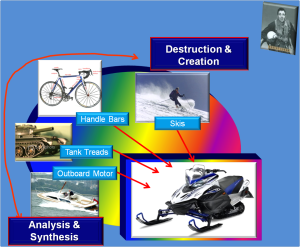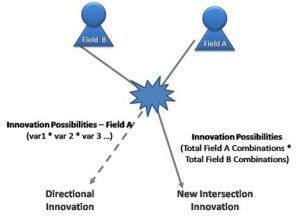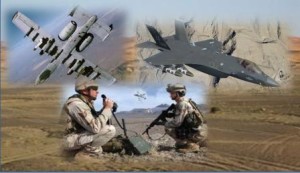Blown Slick Series #7 (Part 2)

… We will use this scheme of pulling things apart (analysis) and putting them back together (synthesis) in new combinations to find how apparently unrelated ideas and actions can be related to one another. Boyd
Part 1 provided an introduction to the Blown Slick analysis process and the boundary conditions and related operational threads as airpower’s past and future are perceived. Throughout the time since airplanes were first employed in warfare, there have been many rules/assumptions/lessons learned, some good, others proven outright wrong, and some still staking their ground. Here in Part 2 the concepts of intersections, triangle perspective, and snowmobiles are introduced. Their application in a manner in which the elements are combined and contrasted with past elements and with those potentially significant as the result of emerging technology will hopefully assist in gaining usable perspective for future airpower.
3. Intersections
Intersectional ideas are those resulting from combining concepts from multiple fields – areas of specialization gained through education and experience – as compared to those created traditionally by combing concepts within a field – noted as directional ideas.

The concept of intersectional ideas stems from the 2004 book The Medici Effect; What Elephants and Epidemics Can Teach Us About Innovation by Frans Johansson.
Mostly focused on individual rather than corporate innovation, it puts forward the thought that creativity and innovation are most likely to occur at the intersection of multiple fields or areas of interest. As used , a field describes disciplines, cultures, and domains in which one can specialize through education, work or experience. An intersection is combining concepts from multiple fields, and of note, when those fields are apparently disassociated, the potential for creativity/innovation is highly probable . Success in intersectional idea generation is seriously dependent upon the breaking down of barriers of association that would stem from the “non relationship” or at best limited context between or among the fields.
While one could easily argue that airpower is indeed a field by itself, for Blown Slick purpose, I think it fairly easy to distinguish the different cultures and operational various sub-cultures of Air Force and Navy, fighter a/c and pilots and bomber a/c and pilots, emerging views on use of unmanned vehicle technology, and the sensor fusion additions and impact on the strike fighter mentality. Thus, while requiring a slightly different definition of cultures/fields than that of the Medici Effect, Johansson’s discussion and key points seem most appropriate for this analysis and desired end state.
Within the Medici context he notes that for an original idea to be creative, it must also have some measure of relevance; it must have value, and that innovations must not only be valuable, they must also be put to use by others. Certainly any analysis of airpower in the face of current issues would note that relevance, value and use are necessary end states.
It is not the purpose here to delineate specific intersections, but rather just to introduce the thought behind intersectional thinking and the plan to use in working up future articles. But as a point of reflection, in the graphic above insert the F-35 multi-role joint strike fighter as the “new intersection/innovation.” For “field A” combine the 1) F-86 of the Korean War, 2) the Air Force Century series fighters, 3) particularly the F-105 and the Navy F-8’s and A-7’s of the Vietnam War, and finally, 4) the F-14, F-15, F-16, and F/A-18’s of the Gulf War and on into today’s operations. These a/c represent 2nd through 4th generation fighters.
One can easily argue that in terms of aerodynamics, performance, systems, and weapons capability they represent a linear progression of fighter aircraft based on airpower usage and technical growth. They represent the extended line “directional growth.” Since that does not coincide with our F-35 insertion, one must ask what is and how was/is “Field B” applied? If the intersection of A and B caused a different result in a/c design, what then should we gather from this intersection about future airpower? What other intersections need be identified and examined to gain actionable understanding?
What I am hypothesizing will be different from other pieces of analysis is that the intersectional tool composed of ideas from multiple sources and lines of thought, will highlight critical insight beyond that from assuming a linear progression of a/c design and operation.
It bears remarking that one aspect of the Medici Effect is the re-statement of Leonardo da Vinci’s belief that in order to fully understand something one needed to view it from at least three different perspectives – leading nicely into the next section.
4. Triangles
Simple to the verge of being trivial, to determine how to get somewhere, one must first know where they are – simple – yes, trivial- maybe, but no less true. At its most basic, triangulation is a process for determining – within the accuracy of the observations in gaining three reference lines from known positions – the boundary lines of your position on the face of the earth and hopefully providing you with actionable understanding for your next move.
From an entirely different perspective, if you can pick any two related subjects, and then note the dynamic inside your boundary as you add a third element: man-woman, add children; peace-war, add nuclear weapons; strike warfare mission – aircraft carrier operations, add night. Change the third element and the whole line of thought on the initial two relationships changes. For naval aviators, changing day to night operations was a transition from “e-ticket ride” to ”only your laundry man knows for sure” full out terror.
The use of three elements for characterizing a situation or environment is not new or just confined to location/navigation. Much study of war has leveraged from On War, Von Clausewitz’s “remarkable trinity” noting the characteristics of all war consist of of 1) primordial violence, 2) chance and probability, and 3) policy and reason; operations can be evaluated by trade-offs among effectiveness, efficiency and risk; business can be viewed as a function of problem, organizational relevance, and opportunity; and test and evaluation requirements can be addressed by understanding the end user’s operational requirement, possible solutions in context of the developers technical and financial constraints, and finally a need to provide answers for both. In my previous work on decision making in severe crisis on Project White Horse 084640, the 1) actors or crisis decision makers (LE, Fire, EM), 2) the situation itself (act of terror, fire, hurricane) – a worst case scenario, and 3) the press of time were traded off to consider type of response and need to gain information for accurate response or immediate need to act immediately to save lives, characterized as gaining relative superiority over an opponent in a critical piece of time.
Again, airpower examination provides many opportunities to see how variables play against two already established relationships, or as in the above, intersections. Continuing the example in the above section, what do we learn or expose for further analysis when we place the F-35 on one point of our triangle and a current strike fighter on another and then vary the mission on the third point between the Close Air Support (CAS) operational mission, and a war-at-sea context such as that presented in AirSea Battle context?
analysis when we place the F-35 on one point of our triangle and a current strike fighter on another and then vary the mission on the third point between the Close Air Support (CAS) operational mission, and a war-at-sea context such as that presented in AirSea Battle context?
5. Snowmobiles
The opening graphic depicts the story Boyd used by way of example to explain analysis/synthesis – destruction/ creation or as noted – the building of snowmobiles concept: taking apart the various vehicles – motor boat, bicycle, etc., then putting selected parts back together to create a whole new entity -analysis/destruction and then synthesis or creation – the snowmobile. This he considered critical for adaptability in the face of a constantly changing hostile environment of war – where the other side – the adversary -always gets a vote.
SUMMARY
The snowmobile creation process then allows us to consider the 1) boundary conditions – or initial conditions – of our airpower environment, 2) the operational threads that by necessity run through that environment, then 3) compare/contrast/combine various aspects through intersections, and then 4) add a third dimension for creating further insight, all in search of actionable understanding when faced with complex or dynamic situations or threat environments.
Number 8 in the Blown Slick series will begin with a look at the elements within airpower itself.





